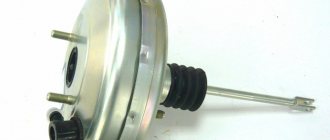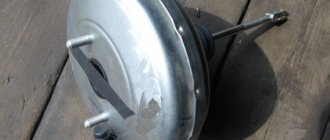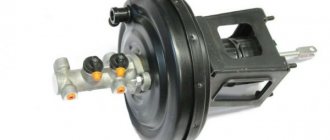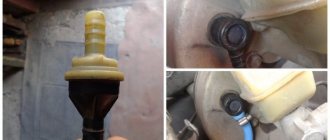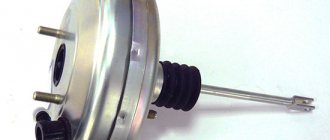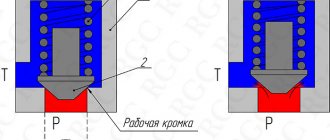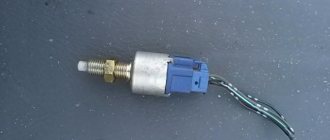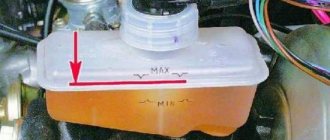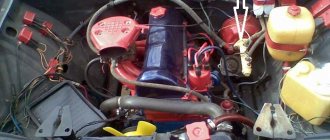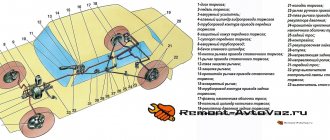How to check the performance of VUT
If according to the relevant signs it has been revealed that the operation of the VUT is impaired, you need to perform a check and find what exactly the malfunction is. To diagnose the brake booster, there is no need to dismantle it.
How to remove
- head 13 with extension;
- flat screwdriver.
We perform dismantling in the following sequence:
Replacing the vacuum booster VAZ 2103 2107
- Inside, use a screwdriver to pry up and remove from the pin the retainer that connects the pusher to the brake pedal.
- We remove the pin itself.
- We unscrew the fastening of the amplifier to the engine shield.
- Unscrew the fastening and remove the GTZ.
- We hook the valve fitting with a screwdriver and remove it from the device body along with the hose.
- We remove the VUT from the car.
How to check the vacuum brake booster of a VAZ 2107
To test the functionality, use honey or any similar sealed bulb. The procedure is as follows:
- Turn off the engine (if it was running).
- Pump up the brake system by pressing the brake pedal very hard a couple of times.
- Press the pedal all the way (it will stop approximately in the middle) and start the engine. If the pedal “sags” still slightly, then the amplifier is working. If not, you need to check the tightness of the connections of the check valve with the rubber hose of the amplifier and the vacuum supply pipe to the amplifier.
To check the non-return valve, it must be removed from its seat by disconnecting it from the rubber hose. Later, firmly insert the rubber bulb into the valve fitting and squeeze the bulb. If the valve is working properly, the bulb remains in a compressed state (it will not take in air). The expansion of the bulb indicates the need to replace the check valve.
A similar method can be used to check the tightness of other connections in the vacuum booster system. If they are in order, you will have to replace vacuum brake booster with a new one.
Adjustment and repair of the unit after checking the vacuum brake booster
In general, adjusting the VUT comes down to adjusting the free play of the brake pedal. To set it correctly, you need to adjust the length of the rod. The adjusting bolt controls the gap/protrusion. Correctly adjusting the position of the bolt itself will allow you to set the perfect valve timing.
VAZ HIDDEN BRAKE ADJUSTMENT THAT NOT EVERYONE KNOWS ABOUT!
When the tightness check is completed, do not forget to adjust the free play of the brake pedal. Adjusting the rod length creates a gap that determines the amount of pressure on the brake cylinder. Therefore, it is very important to set the rod length correctly and set the appropriate gap.
The free play of the pedal when the engine is not running should be from five to fourteen millimeters. This gap is controlled by a bolt located above the plane of the vacuum brake booster.
VUT. How to Adjust Stem Head Protrusion
A small gap leads to jamming of the working cylinder, resulting in rapid wear of the pads and increased fuel consumption of the car. In addition, the car begins to slow down randomly, as if you were driving with a handbrake.
A large gap, on the contrary, leads to an increase in pedal travel, which indicates a violation of the tightness in the assembly.
Above we described how to check the operation of the brake vacuum device and adjust its operation if necessary. Now let's say a few words about its repair.
To ensure your own safety if your amplifier breaks down, take immediate action to repair or replace it. And if you can replace vacuum hoses in gasoline cars or pumps in diesel cars yourself, without resorting to the services of a car service, then it is recommended to entrust more serious work to professionals.
Of course, it costs some money, but when your own safety is at stake, it is better not to skimp. Contact the specialists.
They will not only carry out the inspection competently, but also perform all the necessary work efficiently and with a guarantee.
It should be noted that after repair, it is important to synchronize the wheels when braking and check the ABS/ESP system. This requires a diagnostic stand and specialized equipment.
There are times when it is more expensive to repair a vacuum cleaner than to purchase a used amplifier that is in good condition. Therefore, it is recommended to look for the device at a disassembly site if necessary.
READ Replacement rear beam for Renault Logan 1
If you feel confident in your own abilities and decide, after checking, to repair the faulty vacuum booster , then proceed as follows.
To begin, remove all the upholstery in the engine compartment and remove the windshield trim. Do not remove the tubes leading to the GTZ. This may allow air to enter the system. Next, unscrew the cylinder from the vacuum booster and carefully tilt it forward to prevent deformation of the brake pipes. Before doing this, the vacuum transfer hose must be removed from the amplifier fitting.
Carefully study the recommendations given by the manufacturer and proceed to dismantling the amplifier. Unscrew the mounting bolts and disconnect the terminal of the wire going to the brake light.
Only then remove the pedal using a special tool. If you are well versed in the design of the car, you can cope with checking and repairing the VUT. However, it is better to first go online and find instructions with an amplifier circuit. This will significantly speed up the implementation of the task and increase your chances of success.
How to check the vacuum booster of a VAZ 2107
In most cases, a malfunction of the VAZ 2107 vacuum booster is accompanied by an increase in the force of pressing the brake pedal.
The vacuum booster is installed in the engine compartment of the car, on the left side, and is fastened in the car interior under the steering wheel with four nuts. The amplifier cannot be repaired and if it fails, it is replaced with a new one. Before removing the vacuum booster for replacement, it must be checked to make sure that this is the cause of the breakdown. To check the amplifier, you will need an ordinary medical or any other bulb; it must be sealed. The procedure for checking is as follows:
We carry out the work with the engine turned off. First of all, you need to pump up the system; to do this, press the brake pedal several times. In this case, the pedal should stop halfway, then without removing your foot from the pedal, start the engine, and the pedal should lower slightly, that is, move forward. If it drops, then the amplifier is in good condition. Otherwise, it is necessary to check the tightness of the connection of the check valve (located on the amplifier body) with the rubber hose, and it is also necessary to check the connections of the vacuum supply hose with the inlet pipeline.
If the check valve is faulty, then the necessary vacuum will not be created in the vacuum cavity of the booster, which means the quality of the brakes will be much lower. To check the valve you need to:
- Remove the valve from its seat, having first disconnected the rubber hose.
- Next, insert a bulb into the hole in the fitting (do not confuse it with the rubber hose connection fitting) and press on it so that all the air comes out. If the bulb remains compressed and no air is drawn in, then the valve is working properly. Otherwise, it must be replaced.
Check all connections and rubber hoses for leaks. At this point, the repair work to check the vacuum brake booster of the VAZ 2107 has been completed. After checking, if necessary, replace the amplifier or its individual elements. When installing a new one, do not forget to adjust the booster, namely the drive rod of the main brake cylinder.
Reasons for replacing and adjusting the VAZ 2107 clutch
Replacing a VAZ 2107 clutch is a rather labor-intensive and expensive process. Therefore, before replacing, you should consider adjusting the mechanism.
Clutch replacement
To install a new clutch, you will need an inspection hole, overpass or lift. It is important to detect in time the signs indicating the need to replace the clutch (it is impossible to replace it on the road), and take the car to a garage or car service center. Driving with a faulty clutch is very dangerous - you can get into an accident when crossing a railway crossing or a main road.
The entire VAZ 2107 clutch is replaced, so auto shops sell a kit consisting of a driven disc, a basket and a release bearing. You should consider replacing the clutch in the following cases:
- the car climbs heavily uphill when the accelerator pedal is pressed all the way down, and you can smell a burning smell - these are signs of slipping of the driven part of the clutch;
- when the clutch is disengaged, noises appear in the area of the flywheel housing - this indicates a malfunction of the release bearing;
- when starting the car, it is difficult to engage first gear (the gearbox “growls”) - this is a sign that the clutch is not completely disengaged (the clutch is moving);
- when accelerating, the car begins to twitch, rattling sounds are heard - the reason for this is usually broken damper springs or loose sockets for them on the driven disk, deformation of segments or loose rivets on the hub.
Purpose and location of the unit
The first classic Zhiguli models (VAZ 2101–2102), produced without amplifiers, were distinguished by a “tight” brake pedal. To stop the car suddenly, the driver had to exert considerable effort. In the 70s of the last century, the manufacturer began equipping cars with vacuum boosters (abbreviated as VUT), which significantly increased braking efficiency and made the driver’s work easier.
The unit in the form of a metal “barrel” is installed on the bulkhead between the engine compartment and the interior of the VAZ 2107, on the driver’s side. VUT attachment points:
- the body is screwed to the partition with 4 M8 nuts;
- the master brake cylinder is attached to the booster in front on 2 M8 studs;
- the push rod of the element goes inside the passenger compartment and is connected to the brake pedal lever.
The booster's job is to help the driver apply pressure to the master cylinder rod using vacuum force. The latter is created using vacuum taken from the engine through a special pipe.
The vacuum selection hose is connected to the intake manifold from the side of the channel leading to cylinder III. The second end of the pipe is connected to the fitting of the check valve installed outside the VUT housing.
Essentially, the vacuum booster does the physical work for the driver. The latter only needs to lightly press the pedal for the car to begin to slow down.
The device of the "seven" brake mechanism
The system is designed for smooth or emergency stopping. As we have already determined, it is the main security system, and operation of the car is prohibited even if the slightest malfunction is detected.
In a classic braking system, the pedal is mounted on the same axis as the clutch pedal and is equipped with a return spring. This mechanism has a built-in sensor for turning on the rear brake light lamps.
Next comes the brake master cylinder. It is attached to the body in the engine compartment with two bolts and has working braking circuits for the front and rear wheels.
Now you can find vacuum boosters to reduce the effort applied to the pedal. The drive of such an amplifier is a fitting . It is mounted in the intake manifold, connected by a rubberized pipe. For reliability purposes, the front circuit has two fittings per wheel, and the rear circuit has one fitting.
Main brake cylinder VAZ 2107
Piston disc brakes are used on the front wheels. They are installed for greater braking efficiency, since a greater load is placed on the front wheels than on the rear ones.
Caliper VAZ 2107
The rear wheels are equipped with drum brakes. Structurally, they are much simpler than disk ones. As is known, their efficiency is extremely low, but is quite sufficient for rear-wheel drive vehicles. In addition, it is not profitable for the manufacturer to install more expensive disk mechanisms. A parking brake mechanism is also built into the rear wheel brakes.
Rear hub VAZ 2107
An important mechanism of the system is hidden under the bottom of the car in the rear - this is the pressure drop regulator in the system. This mechanism distributes the pressure that is created during braking between the front and rear circuits.
Differential pressure regulator
Design and principle of operation of VUT
The vacuum amplifier is a metal “barrel” consisting of the following parts (the numbering in the list coincides with the positions in the diagram):
- The body is cylindrical in shape.
- Pressure rod of the main brake cylinder.
- A cover connected to the body by point rolling.
- Piston.
- Bypass valve.
- Brake pedal pusher.
- Air filter.
- Buffer insert.
- Internal plastic housing.
- Rubber membrane.
- Spring for return of the inner housing with membrane.
- Connection fitting.
- Check valve.
- Vacuum pipe.
The letter “A” in the diagram indicates the chamber for supplying vacuum, the letters “B” and “C” are the internal channels, and “D” is the cavity communicating with the atmosphere. Rod pos. 2 rests against the mating part of the main brake cylinder (abbreviated as GTZ), the pusher pos. 6 is attached to the pedal.
The unit is capable of operating in 3 modes:
- The engine is running, but the driver does not press the brake. Vacuum from the manifold is supplied through channels “B” and “C” into both chambers; the valve is closed and does not allow atmospheric air inside. The spring holds the diaphragm in its original position.
- Standard braking. The pedal is partially pressed, the valve releases air (through the filter) into chamber “G”, which is why the vacuum force in cavity “A” helps to press on the GTZ rod. The plastic body will move forward and rest against the piston, and the movement of the rod will stop.
- Emergency braking. In this case, the effect of vacuum on the membrane and housing is not limited; the master cylinder rod is squeezed all the way.
After releasing the pedal, the spring throws the body and membrane back to their original position, and the atmospheric valve closes. The check valve at the inlet of the pipe serves as protection against sudden air injection from the manifold.
Gas breakthrough into the intake manifold and further into the brake booster occurs on extremely worn engines. The reason is a loose fit of the intake valve to the cylinder head seat. During the compression stroke, the piston creates a pressure of about 7-8 atm and pushes some of the gases back into the manifold. If the check valve does not work, they will begin to penetrate into the vacuum chamber, reducing the efficiency of the VUT.
Video: how a vacuum brake booster works
Brake booster malfunctions
Since the braking force is replaced using vacuum, most VUT malfunctions are associated with loss of tightness:
- breakdown of the rubber diaphragm due to critical wear;
- air suction along the edge of the body - at the junction between the two covers;
- the same, through the seal on the GTZ rod;
- problems with the vacuum selection hose - cracks or suction at the joints.
Much less common is failure of the internal bypass valve, clogging of the air filter, and shrinkage of the spring due to natural wear. In very rare cases, the spring breaks into 2 parts.
One day, an acquaintance of mine encountered an interesting effect - the “seven” slowed down tightly after starting the engine. The malfunction was preceded by constant overheating of the brake discs and drums on all wheels. It turned out that two breakdowns occurred inside the vacuum booster at once - the valve failed and the return spring broke. When trying to start the engine, the VUT was automatically triggered by the vacuum, spontaneously squeezing the main cylinder rod. Naturally, all the brake pads were seized - it was impossible to move the car.
Sometimes there is a brake fluid leak between the GTZ flange and the vacuum booster. But this problem does not apply to VUT failures, because fluid is leaking from the main cylinder. The reason is wear and loss of tightness of the sealing rings (cuffs) inside the GTZ.
Troubleshooting
The first sign of loss of vacuum booster seal is not deterioration of the brakes, as many sources on the Internet describe the malfunction. When air just begins to leak through the leaky membrane, the VUT continues to function properly, since the motor manages to maintain a vacuum in the front chamber. The first symptom is changes in the operation of the engine itself:
- due to air leaks into the third cylinder, the engine begins to “trouble” at idle;
- crankshaft revolutions “float”, the stronger the suction, the greater the amplitude of oscillations;
- a running engine reacts to the brake pedal and stalls when pressed sharply;
- Gasoline consumption increases.
If a car owner ignores the primary symptoms, the situation gets worse - the pedal becomes harder and requires more physical effort to slow down and stop the car. The car can be used further; a breakdown of the VUT does not lead to a complete failure of the brakes, but it significantly complicates driving, especially if you are not used to it. Emergency braking will become a problem.
How to make sure that the vacuum booster is leaking:
- Loosen the clamp and remove the vacuum pipe from the fitting on the manifold.
- Plug the fitting with a tight homemade plug.
- Start the engine. If the revs level out, the problem clearly lies in the amplifier.
- Remove the high voltage wire and remove the spark plug for cylinder III. If the VUT fails, the electrodes will be smoked with black soot.
Whenever possible, I use the old “old-fashioned” method - I simply pinch the vacuum hose with pliers while the engine is running. If the third cylinder starts working and idle speed is restored, I proceed to checking the brake booster.
Similarly, the problem can be temporarily fixed while on the road. Disconnect the pipe, plug the fitting and calmly go to the garage or service station - the power unit will operate smoothly, without excessive fuel consumption. But remember, the brake pedal will become hard and stop responding instantly to light pressure.
Additional diagnostic methods:
- Press the brake 3-4 times and start the engine while holding the pedal. If it does not fail, the valve has probably failed.
- With the engine not running, disconnect the hose from the fitting, remove the check valve and firmly insert a pre-compressed rubber bulb into the hole. On a sealed amplifier it will retain its shape, on a faulty amplifier it will fill with air.
Using a bulb, you can accurately determine the location of the defect, but the vacuum booster will have to be removed. While pumping air into the chamber, wash the edges of the joints and the stem seal - bubbles will indicate the location of damage.
Video: how to check the vacuum brake booster on the “seven”
Engine misfire (misfire) when pressing the brake pedal
An air leak through the brake booster can cause misfires while the engine is running. Damage to the diaphragm or internal valve leads to the fact that the optimal ratio of air and fuel is disrupted. Misfire usually occurs when you press the brake pedal while idling.
If checking the vacuum hose, connections and check valve does not reveal anything, you need to perform the following check:
- start the engine at idle speed;
- tighten the handbrake;
- ask another person to press the brake pedal;
- pinch the vacuum hose using pliers (do not forget to place a rag so as not to damage the hose);
- If the engine does not stall and its operation stabilizes, the vacuum brake booster is the culprit for misfires.
Checking engine vacuum using a vacuum gauge
Sometimes the VUT copes well with its tasks, but the motorist still has certain doubts that it is fully operational. If the amplifier on your car did not pass or barely passed the previous tests, you need to make sure that there is enough vacuum. Such diagnostics are performed using a vacuum gauge.
- Disconnect the vacuum hose from the brake booster and connect it through a tee so that you can use a vacuum gauge.
- Start the power unit.
- The sensor should display approximately 400-540 mmHg. Art. If you see a lower value, there is a vacuum leak through the intake manifold (gaskets or crack), hose, engine (cylinder head gasket, etc.) or other components.
Checking VUT with a manual vacuum pump
This method allows you to definitively check the operation of the amplifier. Everything can be done in just a few minutes.
- the engine must idle for about 15-25 minutes to reach operating temperature;
- stop the engine and disconnect the vacuum hose from the check valve on the VUT;
- connect the vacuum pump to the valve;
- apply approximately 500 mm Hg. Art. vacuum to the amplifier;
- wait 5 minutes, a working vacuum booster should hold vacuum normally;
- Without turning off the vacuum pump, press the brake pedal - the vacuum should drop by approximately 125-250 mmHg. Art.; if the vacuum remains at the same level or decreases to zero, the amplifier is faulty;
- Apply vacuum to the amplifier to return it to 500 mmHg. Art.;
- press the brake pedal and hold it in this position for 30 seconds; the vacuum should drop slightly and then be maintained for the remaining 30 seconds; a significant drop in vacuum indicates a faulty VUT.
The principles discussed in this article help to check the vacuum brake booster on most cars - VAZ 2106, 2107, 2109, 2110, 2114, GAZelle, as well as other models of domestic and foreign production.
Replacement instructions
In the vast majority of cases, owners of "sevens" change the vacuum booster assembly, since repairing the unit does not always give a positive result. The main reason is difficulties in assembling, or more precisely, restoring the sealed factory rolling of the housing.
Replacement does not require special conditions or special devices; work is carried out in a garage or in an open area. Tools used:
- a set of sockets with an extension and a ratchet handle;
- socket wrench size 13 mm;
- 7 mm open-end wrench and caliper with depth gauge for adjustment;
- flat and Phillips screwdriver;
- pliers.
Along with the brake booster, it is worth changing the vacuum hose and clamps - old parts can cause air leaks.
Replacement of VUT is carried out in the following order:
- Loosen the clamp and disconnect the vacuum hose from the check valve fitting.
Assembly is performed in the same way, only in reverse order. Before installing a new VUT, be sure to adjust the length of the protruding part of the rod in order to provide the brake pedals with a slight free play. How to make the adjustment:
- Pull out the plastic buffer liner from the side of the GTZ flange, push the rod in until it stops.
- Using a depth gauge (or other measuring device), measure the length of the rod head protruding above the plane of the body. The permissible range is 1…1.5 mm.
It is also recommended to treat the rubber elements with a thick neutral lubricant before installation - this will extend the life of the unit.
Video: replacing the VAZ 2107 vacuum booster with your own hands
Braking system of modern cars
The general braking scheme on modern cars suggests the presence of three main types:
- working;
- spare;
- parking
The working vehicle performs the functions of reducing the speed of the vehicle or stopping it.
The spare vehicle is intended to prevent malfunction or failure of the working system.
The parking vehicle performs the functions of holding the vehicle stationary in special conditions and in parking mode. The VAZ-2107 implements a working and parking vehicle in a “pure” form.
In a modern car, braking can be performed not only by the vehicle itself, but also by the engine, electric or hydraulic transmission brake. In addition, additional systems (or devices) are often implemented that increase the productivity of braking functions:
- anti-lock braking system (the notorious ABS);
- electric brake force distribution (or EBD);
- electrical stabilization system (ESP), etc.
The described devices and systems lead to a significant increase in the cost of the vehicle, and the VAZ-2107 brake system diagram does not provide for them.
However, domestic cars have recently begun to provide similar capabilities.
Unit repair - diaphragm replacement
This operation is unpopular among Zhiguli owners; usually car enthusiasts prefer to change the entire amplifier. The reason is that the result does not correspond to the effort expended; it is easier to buy and install the VUT assembled. If you definitely decide to disassemble and repair the vacuum amplifier, prepare the following tools and consumables:
- assembly spatula, powerful flat screwdriver;
- pliers;
- hammer;
- brush with metal bristles;
- large bench vice;
- repair kit for vacuum amplifiers VAZ 2103—2107;
- silicone sealant.
It is best to buy a repair kit from the Balakovo Rubber Products Plant. This company is a direct supplier of parts for AvtoVAZ and produces high-quality original spare parts.
To carry out repair work, the VUT must be removed from the vehicle, as described in the instructions above. Disassembly and replacement of parts is carried out in the following order:
- Place a mark on the body with a marker, flare the connections with the cover, bending the edges of the shell with a mounting blade.
After assembly, install the unit on the car, having adjusted the rod extension in advance (the procedure is described in the previous section). When finished, check the operation of the amplifier while running.
Video: how to change the VUT diaphragm on a “classic”
Vacuum brake boosters rarely bother Zhiguli owners with breakdowns. There are cases when the factory VUT worked properly throughout the entire life of the VAZ 2107. If the unit suddenly fails, there is no need to panic - a malfunction of the vacuum booster does not affect the operation of the brake system, only the pedal becomes hard and uncomfortable for the driver.
Brake system VAZ 2107
It's no secret that the safety systems provided for the VAZ 2107 have not undergone significant improvements since the first production of the car. There are no airbags or related electronics in such a car. Once you get your hands on such a car, the first thing you need to do is check the brakes. In fact, a car's safety systems are based on the car's braking performance.
Crash test
As crash tests of domestic cars show, it makes no sense to rely on the car body itself. A frontal or side collision with an obstacle already at a speed of 64 km/h will turn the “seven” into an accordion.
Thus, there is no space left for the driver or passengers. Despite all the “unsafety”, the VAZ 2107 is very popular among car owners. Fortunately, it is now not difficult to find spare parts for tuning domestically produced cars and you can modernize your car without any problems.
How to check the vacuum brake booster of a VAZ 2107
To check the functionality, a medical or any similar sealed bulb is used. The procedure is as follows:
- Stop the engine (if it was running).
- Pump up the brake system by pressing the brake pedal firmly several times.
- Press the pedal all the way (it will stop approximately in the middle) and start the engine. If the pedal “sags” a little more, then the amplifier is working. If not, you need to check the tightness of the connections of the check valve with the rubber hose of the amplifier and the vacuum supply pipe to the amplifier.
To check the check valve, it must be removed from its seat by disconnecting it from the rubber hose. Then insert the rubber bulb tightly into the valve fitting and squeeze the bulb. If the valve is working properly, the bulb will remain in a compressed state (will not take in air). Expansion of the bulb indicates the need to replace the check valve.
In a similar way, you can check the tightness of the remaining connections of the vacuum booster system. If they are in order, you will have to replace the VAZ 2107 vacuum brake booster with a new one.
Changing the vacuum booster VAZ 2107
To replace the amplifier you will need a screwdriver, pliers, a 7mm wrench and a 13mm socket.
The procedure for replacing the vacuum booster is as follows:
- Using a screwdriver, pry up and remove the spring clamp of the pin that connects the pusher to the brake pedal
- Remove the amplifier mounting pin.
- Unscrew the mounting bolts and remove the master brake cylinder attached to the vacuum booster (located in the engine compartment).
- Using a 13 mm socket, unscrew the nuts securing the VAZ 2107 vacuum booster.
- Remove the vacuum hose fitting from the amplifier by prying it up with a screwdriver. The operation must be done carefully so as not to damage the fitting.
- Remove the amplifier
Installing a new vacuum booster is carried out in the reverse order. Before installation, it is necessary to set the amount of protrusion of the rod head relative to the plane of the amplifier. It should be 1.05-1.25 mm. This ensures free play of the brake pedal of 3-5 mm.
The rod head is adjusted using a 7 mm wrench, which should be used to rotate the head while holding the rod with pliers.
How to check the vacuum brake booster of a VAZ 2107
To check the functionality, a medical or any similar sealed bulb is used. The procedure is as follows:
- Stop the engine (if it was running).
- Pump up the brake system by pressing the brake pedal firmly several times.
- Press the pedal all the way (it will stop approximately in the middle) and start the engine. If the pedal “sags” a little more, then the amplifier is working. If not, you need to check the tightness of the connections of the check valve with the rubber hose of the amplifier and the vacuum supply pipe to the amplifier.
To check the check valve, it must be removed from its seat by disconnecting it from the rubber hose. Then insert the rubber bulb tightly into the valve fitting and squeeze the bulb. If the valve is working properly, the bulb will remain in a compressed state (will not take in air). Expansion of the bulb indicates the need to replace the check valve.
In a similar way, you can check the tightness of the remaining connections of the vacuum booster system. If they are in order, you will have to replace the VAZ 2107 vacuum brake booster with a new one.
Changing the vacuum booster VAZ 2107
To replace the amplifier you will need a screwdriver, pliers, a 7mm wrench and a 13mm socket.
The procedure for replacing the vacuum booster is as follows:
- Using a screwdriver, pry up and remove the spring clamp of the pin that connects the pusher to the brake pedal
- Remove the amplifier mounting pin.
- Unscrew the mounting bolts and remove the master brake cylinder attached to the vacuum booster (located in the engine compartment).
- Using a 13 mm socket, unscrew the nuts securing the VAZ 2107 vacuum booster.
- Remove the vacuum hose fitting from the amplifier by prying it up with a screwdriver. The operation must be done carefully so as not to damage the fitting.
- Remove the amplifier
Installing a new vacuum booster is carried out in the reverse order. Before installation, it is necessary to set the amount of protrusion of the rod head relative to the plane of the amplifier. It should be 1.05-1.25 mm. This ensures free play of the brake pedal of 3-5 mm.
The rod head is adjusted using a 7 mm wrench, which should be used to rotate the head while holding the rod with pliers.
Clutch adjustment VAZ 2107
Clutch adjustment is a mandatory step after troubleshooting or replacement. When dismantling the gearbox, basket, or driven disk, the control rod is usually unscrewed, so after assembly, the adjustment must be done again. This is also necessary if during the operation of the car, for one reason or another, the clutch on/off mechanism is broken. It's quite easy to make the adjustment yourself. To do this, you will need an inspection hole, overpass or lift.
Tools and materials
- open-end wrenches for 8, 10, 13 and 17;
- measuring ruler or construction corner with divisions;
- pliers;
- Cobra pliers;
- water-repellent composition WD-40.
The clutch adjustment is carried out after bleeding the hydraulic drive.
Adjusting the pedal free play
The pedal free play should be from 0.5 to 2.0 mm. It is regulated from inside the car by changing the reach of the clutch pedal limiter.
The procedure for this is as follows
- Using one 17mm wrench, loosen the locknut by 2-3 turns, and with the other same wrench, rotating the head of the limiter, change its length.
Adjusting the free play of the fork rod
The free play of the fork rod is the gap between the release bearing and the fifth diaphragm spring of the pressure plate. Its adjustment is carried out on the inspection pit or lift as follows.
- To make it easier to control the free movement of the fork, use pliers to remove the ends of the return spring from the clutch fork and from the plate under the working cylinder mounting bolts.
Adjusting the fork rod
The threaded part of the rod is not protected from dirt and moisture, so the adjusting nut and locknut may not immediately unscrew. It is recommended that after cleaning the rod from dirt, apply WD-40 to the threaded part. You are then prompted to perform the following steps.
- Holding the adjusting nut with a 17 wrench, use a 13 wrench to loosen the lock nut by 2-3 turns.
After adjustment, it is recommended to check the operation of the clutch. To do this you need:
- start and warm up the engine to operating temperature;
- Depress the clutch pedal and engage first gear;
- turn off first gear and engage reverse.
A properly adjusted clutch should press out easily, without jamming. Speeds switch on without difficulty or noise. When driving, there should be no slipping of the driven disk.
How to check the vacuum brake booster
The vacuum brake booster is an indispensable part in the braking system of many cars. It is necessary so that when you press the brake pedal, additional force is created, due to which the brake system mechanisms will operate quickly and efficiently, ensuring the car stops in a minimum time.
Like any other part of the car, the vacuum brake booster can fail. Most often this happens due to prolonged use of the machine and parts without replacement. If the booster fails, the brakes will not stop working, but it will become somewhat more difficult to control how quickly the car stops. When there is a suspicion of failure of the vacuum brake booster, it must be checked, and then a decision must be made on the advisability of repair or replacement.
Parking brake malfunction
This defect is the most common when the car moves involuntarily even with the handbrake locked. This is due to wear on the pads, discs or drums, as well as stretching of the cable elements.
According to the requirements of the “List...”, a parked vehicle must ensure that the passenger car is stationary:
- on a slope of up to 16% at full load;
- on a 23% slope when equipped.
In the event that these requirements are not met, the vehicle can only be driven to a parking or repair site. Repair of the malfunction is ensured by adjusting the cable tension with a special nut or replacing worn parts.
Signs of a faulty vacuum brake booster
Due to prolonged operation of the vacuum brake booster without replacement, defects may appear in it. Most often, the problem manifests itself in mechanical damage to the connection of the hose connecting the amplifier and the engine intake manifold. Mechanical damage or the formation of cracks in the rubber will lead to the fact that a vacuum will not be created in the working chamber of the mechanism, and this is necessary for its proper operation.
Internal parts in the vacuum brake booster can also fail, for example, the valve will lose elasticity or the working surface of the diaphragm will be damaged.
A malfunction of the vacuum brake booster can be determined by the following signs:
- The car began to brake worse with the same pressure on the pedal;
- When you press the brake pedal, you hear hissing sounds, at which point the engine speed may increase;
- The car starts to shake;
- Fuel consumption increases when the machine operates in the previous mode.
In some situations, other problems may arise in the operation of the car due to problems with the vacuum brake booster. For example, spark plugs may stop firing.
Possible mechanism malfunctions
The first sign of a breakdown of the brake system vacuum booster is an increase in effort when pressing the pedal (if the device is in working order, pressing the brake pedal is soft and smooth). In this case, the brake mechanism continues to work, but causes inconvenience in driving. The driver needs to make more and more efforts to reduce speed in a timely manner. The part in question cannot be repaired, so if it malfunctions, it will need to be replaced. If you do not replace the vacuum booster on the VAZ 2107, then such operation of the car may result in an accident.
The design of the device in question includes the following parts:
- steel body or base;
- valve;
- polymer membrane;
- rubber membrane.
The following types of malfunctions of the mechanism in question are distinguished:
- Damage inside the device. Typically, internal failures include damage to the diaphragm, as well as wear of the rubber base. In the event of such malfunctions, air bleeding will occur.
- The appearance of a crack in the membrane, as well as a complete violation of its integrity.
- Failure of the valve mechanism.
- The hose that connects the mechanism to the engine intake manifold is damaged. Damage usually occurs at the joint, often due to a loose clamp. It is easy to identify such a breakdown, since it will cause signs of hissing.
The hissing does not always appear, but only when you press the pedal, so it is not difficult to identify a system malfunction. At one point, if such a breakdown is not repaired, the brake hose may become damaged, which will cause the brakes to disappear.
The brake master cylinder is connected to the booster, so when replacing the device, these parts should be disconnected. Before replacing the vacuum seal, you will need to make sure that the amplifier is really faulty and cannot be used in the future.
How to check the vacuum brake booster
Checking the vacuum brake booster is a simple procedure that even a novice car enthusiast can handle. To determine if a part is malfunctioning, it does not need to be removed from the machine; all you need to do is perform 3 simple tests that indicate the problem.
Test 1
The car must be started and allowed to idle for about 5-7 minutes. Next, the engine is turned off, and the driver needs to fully depress the brake pedal to create a vacuum in the brake booster. The pedal is then released and pressed down again.
If there is a problem with the vacuum brake booster, the second time you press the brake pedal, the pedal travel will be significantly less than the first time because vacuum can no longer be created. In a situation where the second press does not differ from the first along the pedal stroke, we can conclude that the system is working properly or, if there is no certainty, move on to the next test.
Test 2
When the car engine is turned off, you need to press the brake pedal several times (6-8). Next, the pedal is depressed as much as possible and the engine starts. If there are no problems with the operation of the vacuum brake booster, a vacuum will begin to create in the system. As a result, the membrane presses on the rod, it pulls the pusher, which is connected by a mechanism to the pedal. Accordingly, at this moment the pedal, even if it is pressed all the way, will begin to drop slightly even lower.
If the fully depressed pedal does not budge after starting the engine, we can conclude that no vacuum has been created in the system. Accordingly, there are malfunctions that interfere with this process.
Test 3
The third way to check the vacuum brake booster allows you to determine whether there are air leaks. To carry out diagnostics, you need to start the car engine. Next, the pedal is pressed all the way and the engine is turned off.
If within 30 seconds the pedal does not deviate from the maximum depressed state, there are no problems with the vacuum brake booster. When, after releasing the pedal, it begins to return to its reverse position under the action of the return spring, this indicates that the pressure inside the working chamber increases, which indicates a malfunction of the mechanism.
Sources:
https://remont-vaz2106.ru/kak-proverit-vakuumnyj-usilitel-vaz-2107 https://bumper.guru/klassicheskie-modeli-vaz/tormoza/vakuumnyy-usilitel-tormozov-vaz-2107.html https: //www.vazzz.ru/kak-proverit-vakuum-na-vaz-2107-zamena-poryadok-dejstvij-shema/ https://semerkavaz.ru/raznoe/kak-zamenit-vakuumnyjj-usilitel-vaz-2107/ https://okeydrive.ru/kak-proverit-vakuumnyj-usilitel-tormozov/
Vacuum booster device
1 — tip mounting flange; 2 - amplifier housing; 3—rod; 4 - cover; 5 - piston; 6 — amplifier mounting bolt; 7 - spacer ring; 8 — valve spring support cup; 9 - valve; 10 — valve support cup; 11 — return spring support cup; 12 — protective cap; 13 — holder of the protective cap; 14 — pusher; 15 — air filter; 16 — valve return spring; 17 — valve spring; 18 — housing cover seal; 19 — retaining ring of the seal; 20 - thrust plate; 21 - buffer; 22 — valve body; 23 - diaphragm; 24 — valve body return spring; 25 — rod seal; 26 — master cylinder mounting bolt; 27 — rod seal cage; 28 — adjusting bolt; 29 — hose tip; 30 - valve; A - vacuum cavity; B - channel connecting the vacuum cavity with the internal cavity of the valve; C - channel connecting the internal cavity of the valve with the atmospheric cavity; E - atmospheric cavity
If moving the brake light switch fails to eliminate incomplete release of the brake mechanisms, then disconnect the brake master cylinder from the vacuum booster and check the protrusion of the adjusting bolt 28 relative to the mounting plane of the master cylinder flange (size 1.25-0.2 mm). This size can be set by holding the end of rod 3 with a special wrench and tightening or unscrewing bolt 28 with another wrench.
Sources
- https://provaz07.ru/tormoza/menyaem-vakuumnyj-usilitel-tormozov-vaz-2107.html
- https://semerkavaz.ru/raznoe/kak-zamenit-vakuumnyjj-usilitel-vaz-2107/
- https://ovaze.ru/78-regulirovka-privoda-tormoza.html
- https://www.drive2.ru/l/541383308794135342/
[collapse]

